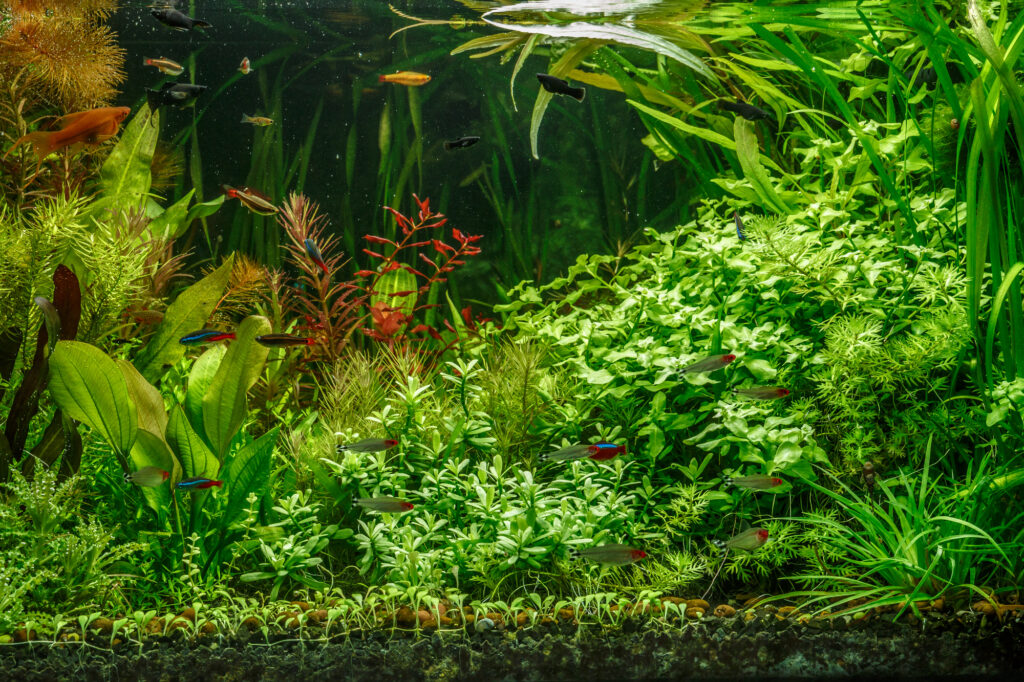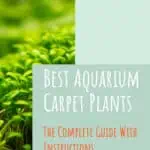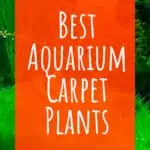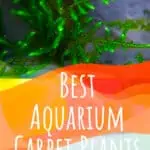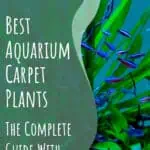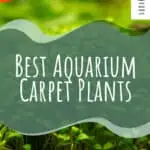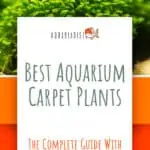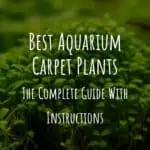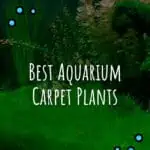Aquatic plants make a beautiful addition to almost every tropical freshwater fish tank.
Carpeting plants can fill in the aquarium’s foreground, adding a lush green, lawn-like carpet that provides shelter for shy fish and vulnerable fry. Some carpet plants also create glittering oxygen bubbles when you give them plenty of light and CO2.
You’ll need a well-lit tank to provide carpet plants with enough light to thrive. Some species are slow-growing while others are fast-growing plants, rapidly covering the substrate in a dense carpet of glorious green leaves.
The variety of carpeting plants you choose depends on the aesthetic you want to create, the size of your tank, and the amount of lighting you can provide for the plants. Read this guide to discover our favorite 11 aquarium carpet plants.
11 Best Aquarium Carpet Plants
Here are our 11 favorite aquarium carpet plants for freshwater tropical fish tanks.
Java Moss
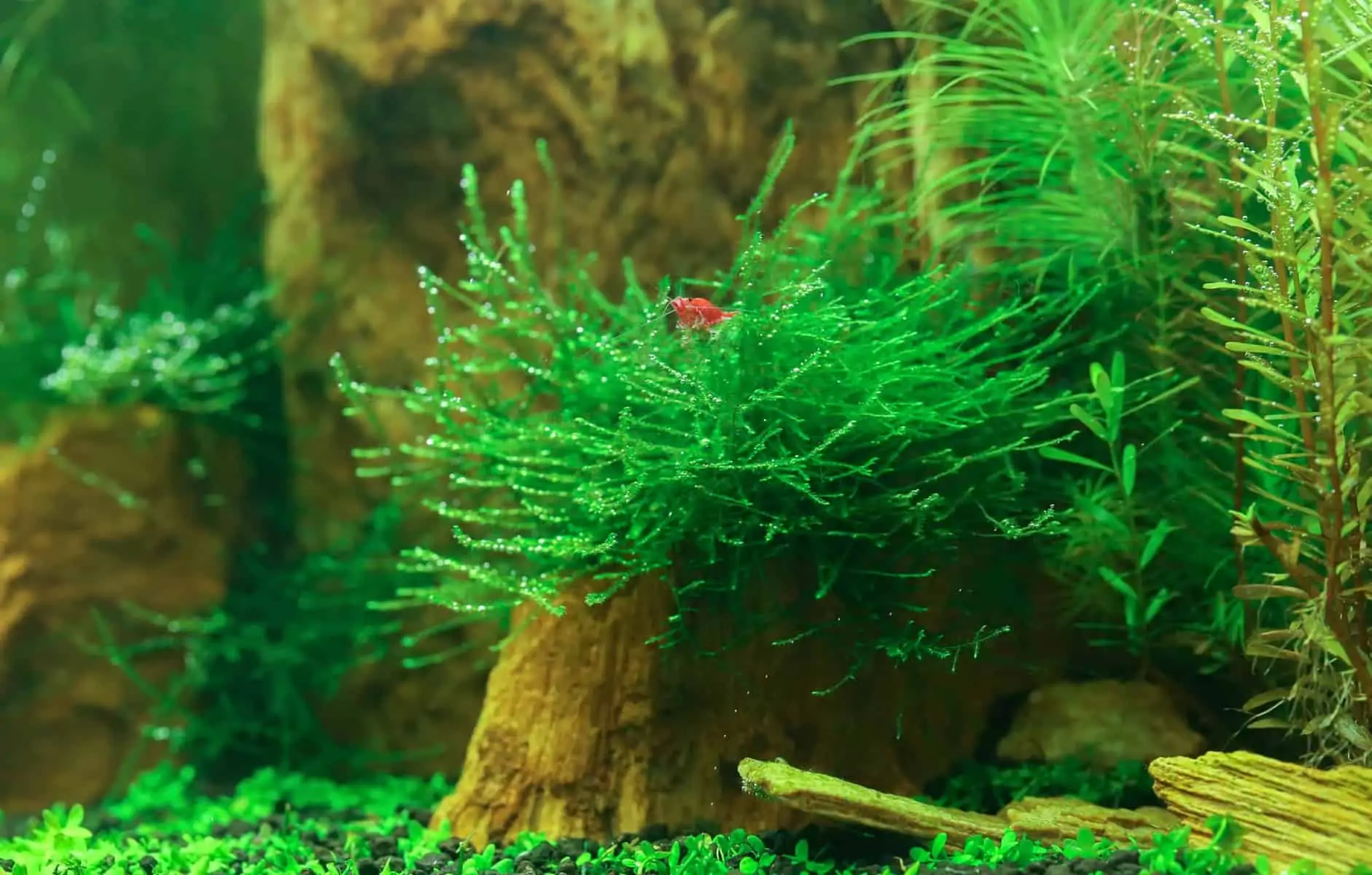
- Scientific name: Taxiphyllum barbieri
- Care difficulty: Beginner-friendly
- Light level: Low
- Growth rate: Fast
Java Moss is readily available and an incredibly hardy plant making it an excellent choice for beginners.
This versatile plant can be used as a mid-ground or foreground plant, a free-floating plant, or attached to driftwood and rocks. Java moss doesn’t need CO2, fertilization, or supplemental light to thrive. You can grow this plant under standard fluorescent lighting.
All you need to do to propagate Java Moss is to take cuttings from the plant, using sharp scissors, and fix them onto hard objects with a piece of fishing line or dental floss, or bury small sections of the plant in the substrate.
Dwarf Baby Tears
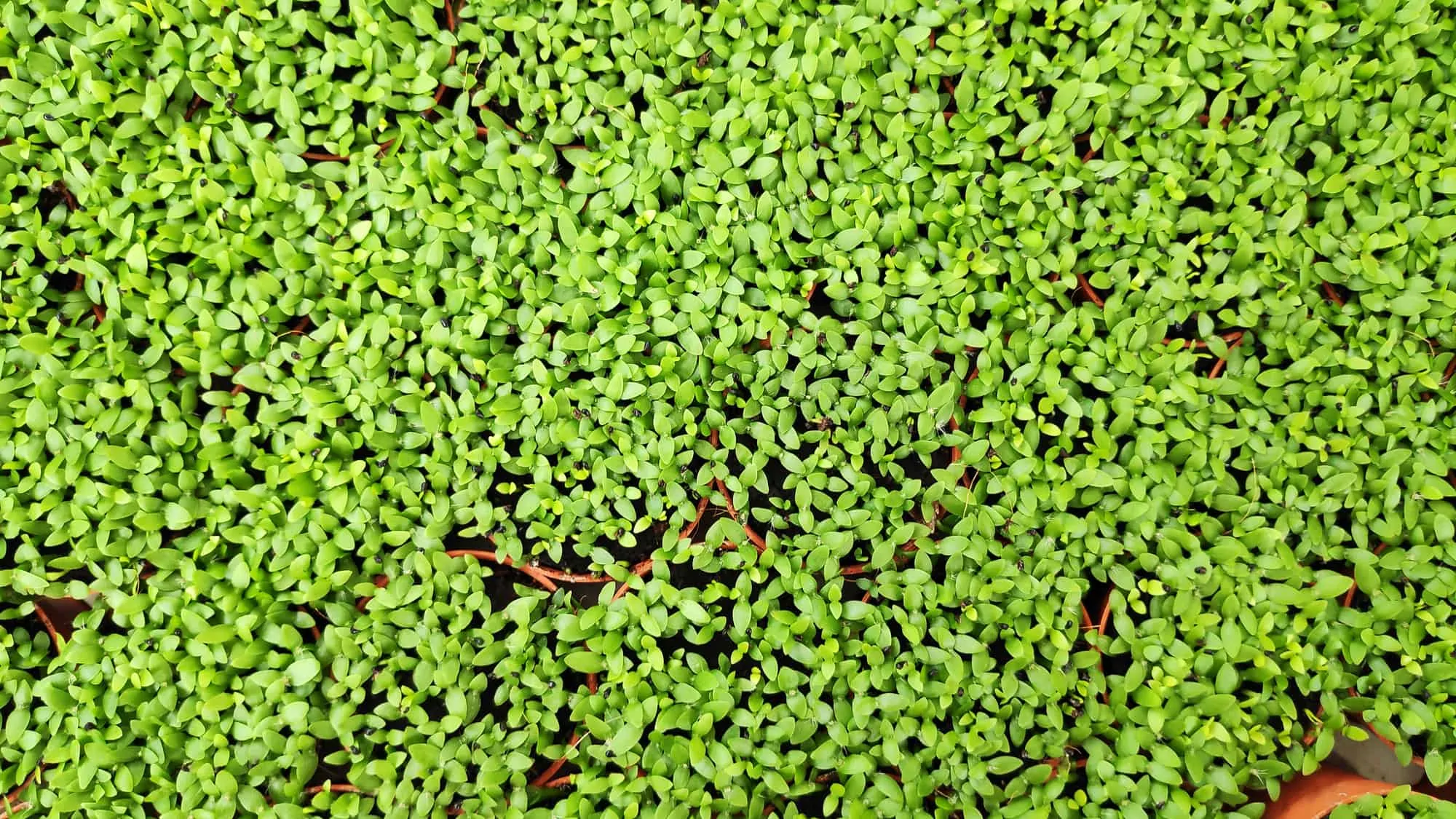
- Scientific name: Hemianthus callitrichoides
- Care difficulty: Intermediate
- Light level: Medium to High
- Growth rate: Slow
Dwarf Baby Tears is found in Cuba and is one of the smallest aquatic plants in the world! Dwarf Baby Tears leaves are just a few millimeters long and the plant grows emersed and submerged along the water’s edge.
These plants need large amounts of light and high levels of CO2 to thrive. The plant has a medium growth rate and it takes quite a while to create a thick carpet. You’ll need to provide the plant with a rich substrate to encourage it to send out runners and spread.
Buy small clumps of Dwarf Baby Tears and plant them a few centimeters apart to encourage the plant to cover the substrate.
Dwarf Sagittaria
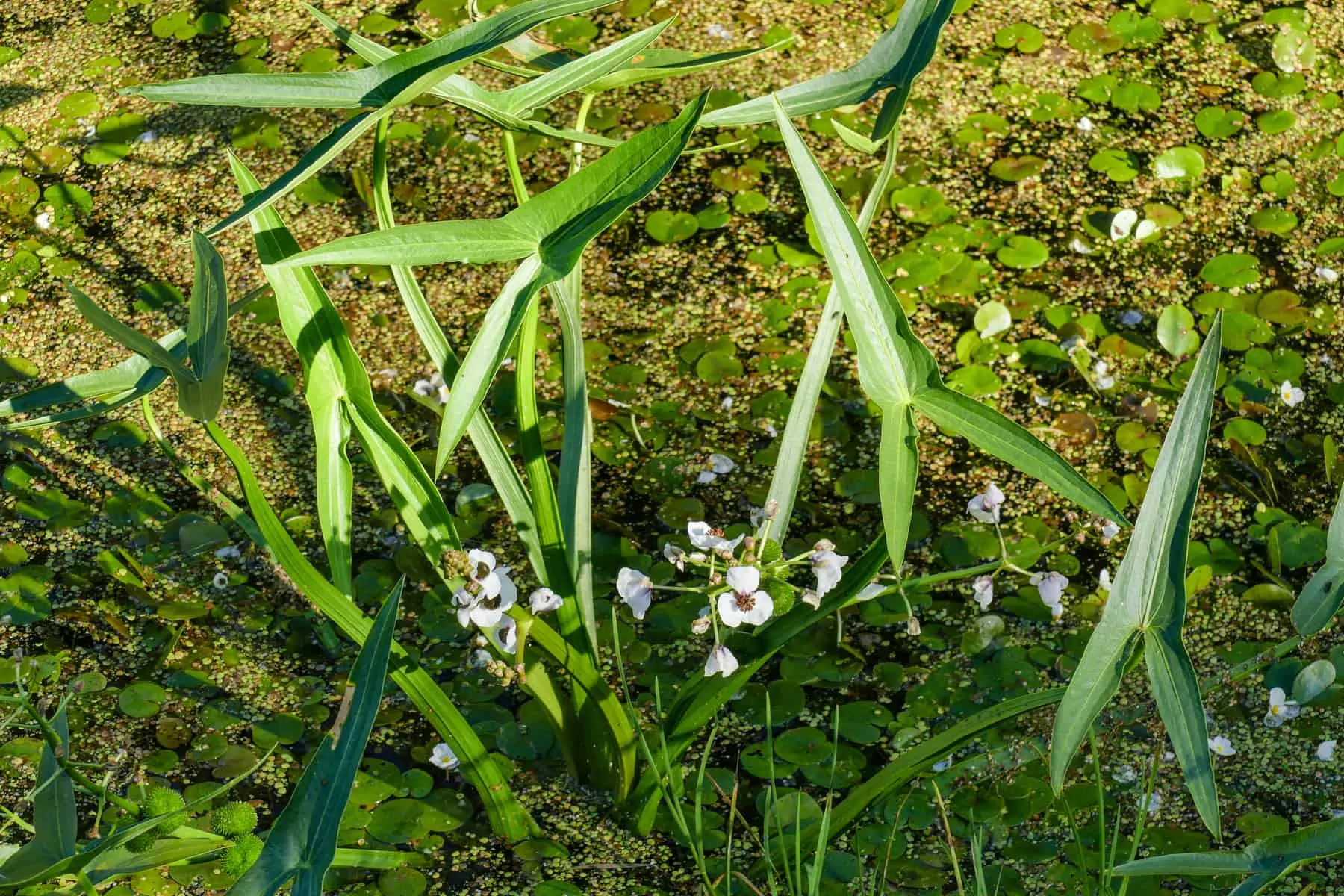
- Scientific name: Sagittaria subulata
- Care difficulty: Intermediate
- Light level: Medium
- Growth rate: Fast
Dwarf Sagittaria can work well as a carpeting option, provided that you give the plant the conditions it needs to thrive. Under high lighting levels, Dwarf Sagittaria grows in clumps sending out runners laterally that form a dense carpet of green leaves 3 to 5 inches high.
If the lighting in the tank is low the plant can grow up to 12 inches tall, so it doesn’t make a good carpeting plant. However, the plant can make an excellent background plant and doesn’t require CO2 or additional fertilizer to grow well.
Dwarf Sagittaria tolerates alkaline, hard water, and can even do well in slightly brackish conditions. That makes this plant a rare foreground or carpet plant that’s suitable for Rift Lake and brackish tanks.
Dwarf Water Trumpet
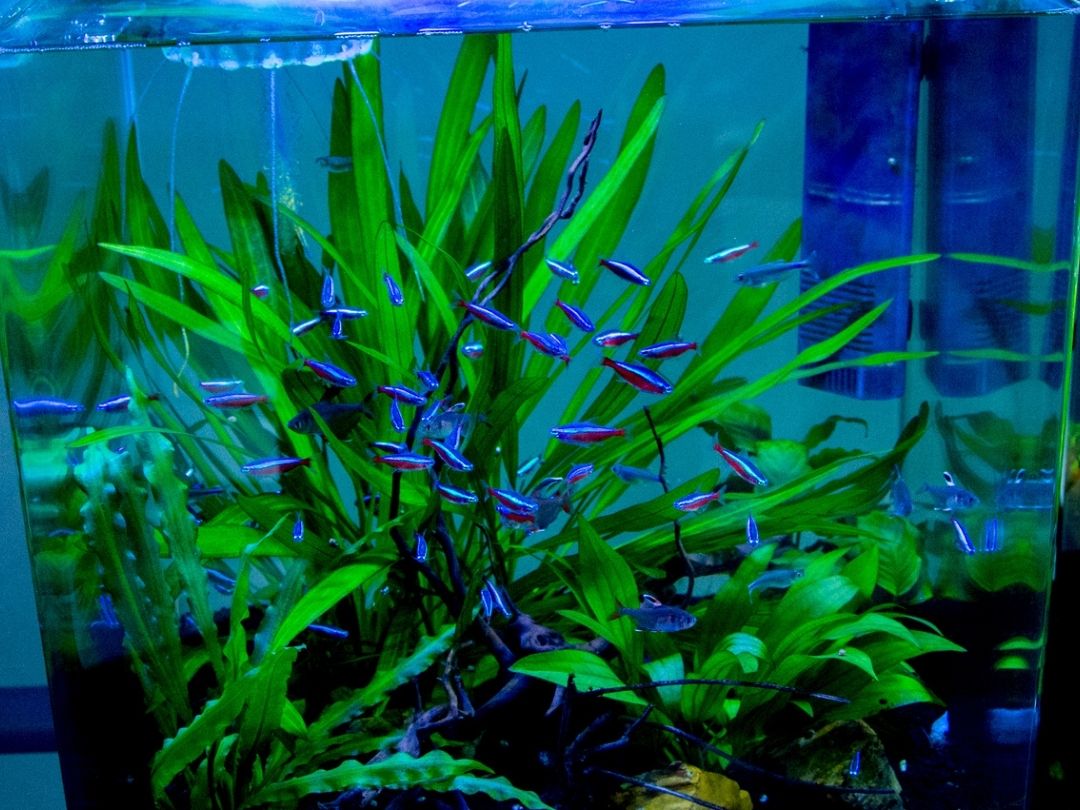
- Scientific name: Cryptocoryne parva
- Care difficulty: Intermediate
- Light level: High
- Growth rate: Slow
Cryptocoryne parva has higher light requirements than other members of the Crypt family that generally grow under tree canopies in the slow-moving, shallow waterways of Sri Lanka.
This plant needs high lighting levels to thrive, and without them, it won’t have sufficient energy to spread over the substrate. Although many other Crypts change color depending on the degree of light they’re receiving, Crypt Parva remains a pale grassy green.
This slow-growing plant rarely tops 2 inches tall, and although supplementation can encourage growth, good lighting levels are more likely to encourage the plant to grow and thrive.
Thanks to its low-growing habit, you rarely need to trim Crypt parva. Once the plant is established, it makes an excellent low-maintenance carpeting plant for a mature tank with high light levels.
Christmas Moss
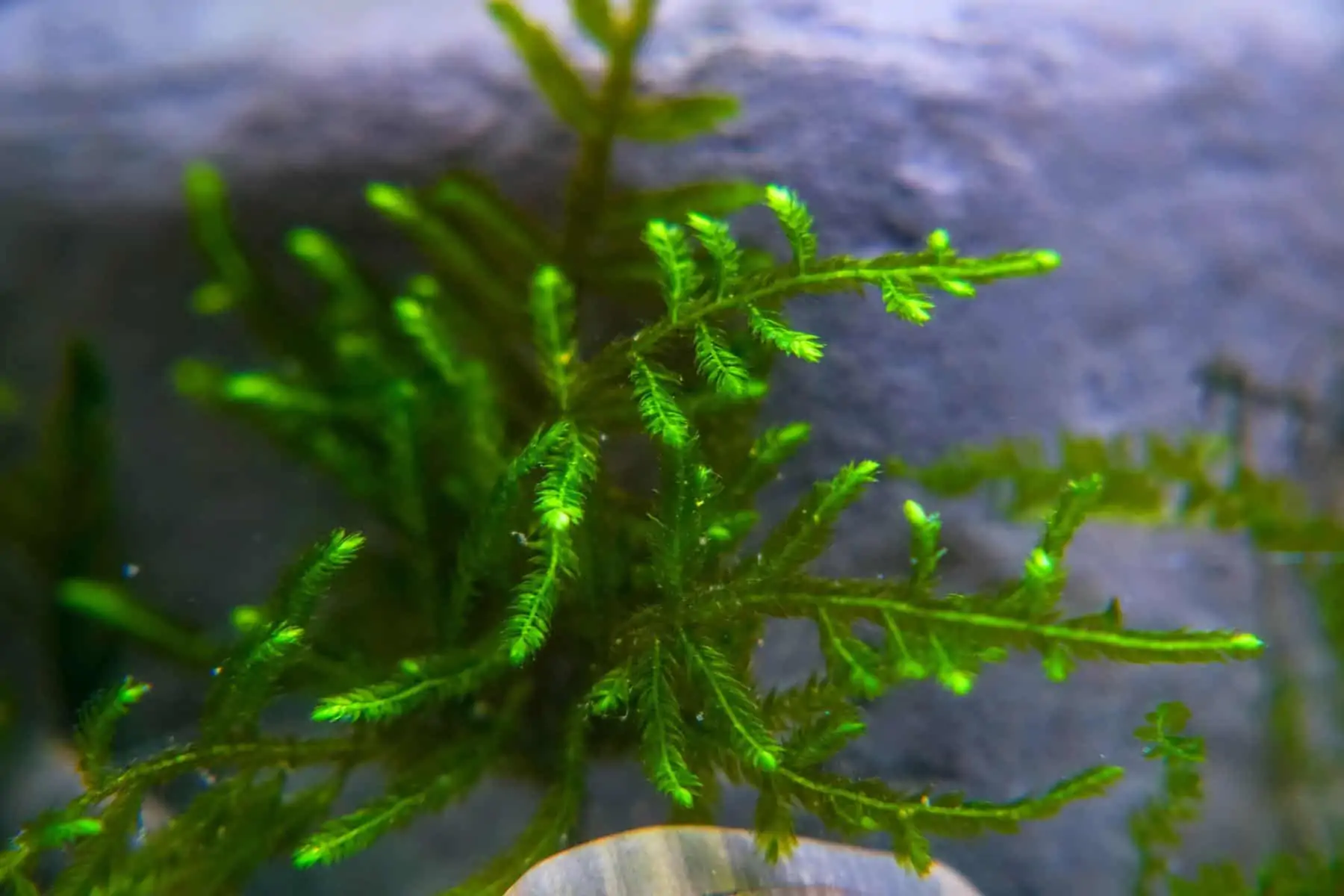
- Scientific name: Vesicularia montagnei
- Care difficulty: Intermediate
- Light level: Medium to High
- Growth rate: Slow
Christmas Moss doesn’t grow as rapidly as Java Moss and isn’t as hardy. The plant also has more compact branching leaves that look like tiny fir trees, hence the plant’s common name.
The plant’s tiny green leaves are round and grow at right angles to the main stem. However, if you leave the plant unattached it will develop a more chaotic look similar to Java Moss.
Christmas Moss can be used as a foreground carpet plant or attached to driftwood, smooth stones, and rocks. You can even create a canopy of the plant that replicates a forest of miniature Bonsai trees.
For optimum growth, Christmas Moss needs medium to high lighting. As the plant is a column feeder, a rich substrate isn’t required but the plant does benefit from supplemental CO2. You can grow Christmas Moss emersed and it makes an excellent carpet plant choice for paludarium tanks.
Dwarf Hairgrass
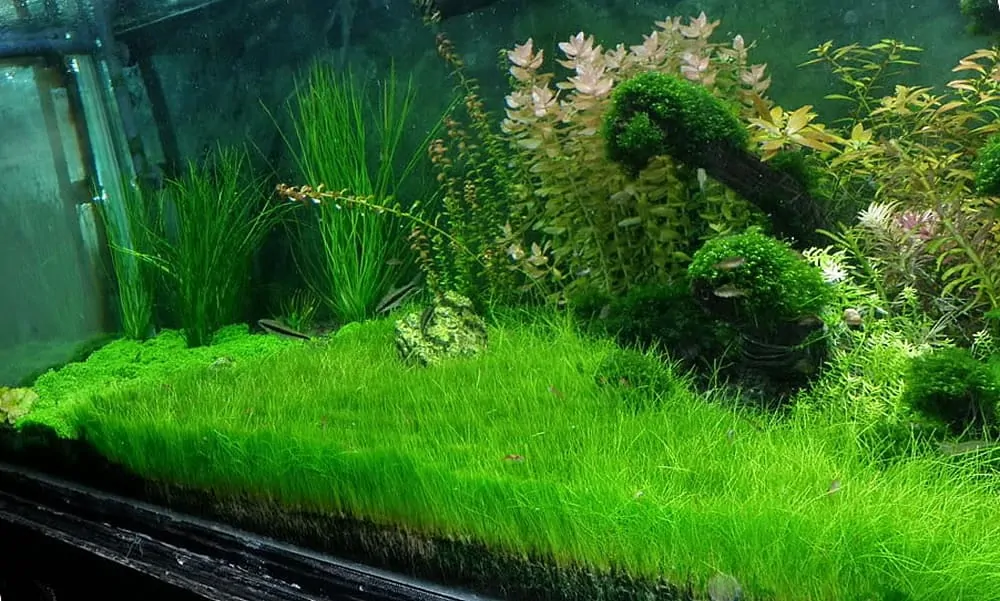
- Scientific name: Eleocharis parvula
- Care difficulty: Intermediate
- Light level: Medium to High
- Growth rate: Medium
Dwarf Hairgrass, also known as Dwarf Spikerush, is a salt-tolerant plant that grows both submerged and emersed. The plant grows slightly quicker above the waterline but still makes an excellent aquarium plant if you care for it properly.
Dwarf Hairgrass is usually sold in clumps in pots, but if you simply remove the plant from its pot and put it into the substrate it will most likely grow upward. To encourage the plant to grow as a carpet, you need to split it into sections of four to six blades.
Plant the blades ½ to 1 inch apart in fine gravel or a fertile sand substrate so that the plants spread without crowding one another.
Dwarf Hairgrass prefers a small-grained sandy substrate rather than large gravel. The plant takes most of its nutrients from its roots instead of the water column, so you may want to use root supplement tabs to feed the plants and encourage optimum growth.
If you want to grow this plant as a carpet, you’ll need to provide it with high levels of ample lighting. Keep trimming the plant to under 2 inches in height and you’ll be rewarded with a beautiful aquarium lawn.
Dwarf Water Clover
- Scientific name: Marsilea minuta
- Care difficulty: Intermediate
- Light level: High
- Growth rate: Slow to medium
If you want to cover your substrate with a carpet of lucky four-leaf clovers, then the Dwarf Water Clover is probably worth considering.
This plant is a small fern that’s a native of tropical Asia and Africa and can be grown both emersed and submerged. When the plant is grown underwater, it takes on a highly variable growing style depending on what level of lighting you provide.
With bright lighting conditions, the Dwarf Water Clover takes on a perfect carpet growth pattern that’s ideal for covering the substrate with verdant green leaves. If light levels are low, the plant shoots to the surface in search of light and the leaves that grow on the water surface look like miniature lily pads.
You don’t need to provide the plant with CO2, although that will encourage more vigorous growth and propagation. There are several other plants in the Marsilea genus that offer different leaf shapes and all have similar requirements.
All these species are wonderful aquatic plants that can be grown successfully in the aquarium when provided with sufficient lighting and a fertile substrate.
Glossostigma Elatinoides
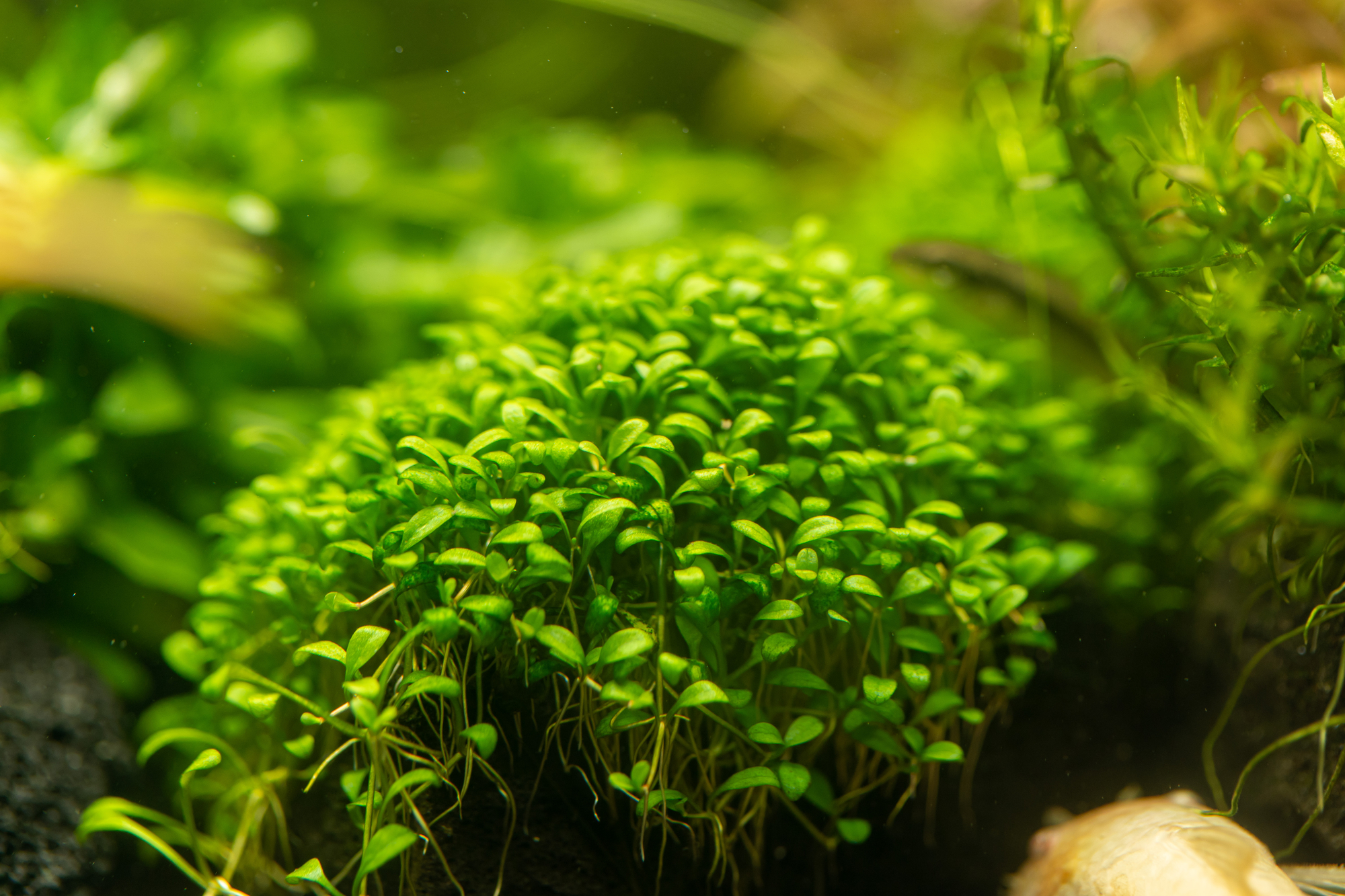
- Scientific name: Glossostigma elatinoides
- Care difficulty: Intermediate
- Light level: Very High
- Growth rate: Fast
Glossostigma elatinoides is found in New Zealand and Southeast Australia where it grows in shallow water as a bog plant. The water is soft and the plant’s habitat alternates between exposure and flooding.
The main problem with growing Glossostigma elatinoides is that it inhabits rich soil and that makes this a very hungry carpet plant to grow in your fish tank. If the plant doesn’t receive enough light, it will grow upward toward the surface losing its low and compact growth.
For Glossostigma elatinoides to grow well, it needs to be provided with a fertile substrate, CO2, and intense lighting.
The Glossostigma elatinoides that you buy from fish stores are supplied in tight bunches. However, you need to split the individual plants and plant them roughly a centimeter apart. You’ll need to plant enough stems to cover a minimum of 70% of the area you want to carpet.
When planted in that way, Glossostigma elatinoides will cover the area with beautiful green growth within a month or so.
Brazilian Micro Sword
- Scientific name: Lilaeopsis brasiliensis
- Care difficulty: Intermediate
- Light level: High
- Growth rate: Slow
Brazilian Micro Sword, commonly known as Copragrass, is one of the most popular plants with aquarists who want to grow a glorious grassy lawn in their tanks.
Although the plant is readily available in most pet stores, it’s notoriously difficult to grow and care for, so we would not recommend the Brazilian Micro Sword plant for beginners.
These plants need high lighting levels, a nutrient-rich substrate, and CO2 supplementation to grow and thrive. Ideally, you need to enrich the sandy substrate with root tabs, organic matter, and soil-based substrates to encourage good growth.
Even when well cared for, the Brazilian Micro Sword plant is painfully slow to grow.
The plants send out runners that eventually cover and carpet the substrate, but Micro Swords are very slow to become established.
You typically buy the plants in pots. Break the plants up into small clumps and plant them across the substrate to accelerate growth. You can also grow Brazilian Micro Sword in brackish conditions.
Be careful not to place larger species that will shade the Brazilian Micro Sword, as that will stunt the plant’s growth.
Blyxa Japonica
- Scientific name: Lilaeopsis brasiliensis
- Care difficulty: Intermediate
- Light level: High
- Growth rate: Slow
Blyxa Japonica is found growing wild throughout tropical Asia. The plant grows taller than many carpet species, forming a dense carpet over time. Although this is a beautiful plant, it can be challenging to grow so we would not recommend it for beginners.
Over time this plant will grow to form a tight bush and it will carpet your substrate. However, Blyxa Japonica doesn’t grow quickly and it doesn’t spread as well as other carpet species.
It’s best to plant Blyxa Japonica in groups across the bottom of your tank where it will eventually spread to create a carpet.
Blyxa japonica prefers soft and acidic conditions, CO2 supplementation, a fertile substrate, and high lighting conditions. When provided with these optimum conditions, Blyxa Japonica grows in an attractive compact form and assumes a reddish to the golden hue that makes this plant unique among aquatic carpet plants.
However, if you fail to provide the plant with what it needs it will probably die off or simply remain green. If you don’t provide Blyxa japonica with sufficient light or grow it beneath shading plants, it will grow taller to reach the light, which will be useful to a midground plant.
Utricularia Graminifolia
- Scientific name: Lilaeopsis brasiliensis
- Care difficulty: Difficult
- Light level: Medium to High
- Growth rate: Slow
Utricularia graminifolia is a carnivorous plant that belongs to the Bladderwort family. The plant traps aquatic organisms, such as plankton and free-floating infusoria, using hair-like triggers that trap the prey, which is then slowly digested by the plant.
This is quite a challenging plant to grow successfully in the aquarium due to its feeding and growing requirements. Utricularia graminifolia doesn’t use true roots but will either attach itself to hard surfaces or grow free-floating.
Eventually, the plant will send out runners and produce a carpet-like effect.
Utricularia graminifolia can be grown without fertilizer since it feeds on aquatic organisms instead. You’ll need acidic water conditions to grow this plant successfully, as Utricularia graminifolia grows in marshy environments. You can add peat to your substrate to create the perfect water chemistry for the plant.
Final Thoughts
Did you enjoy our guide to carpet plants that you can grow in your home aquarium? If you found the information in this article helpful, please feel free to share it.
Carpet plants can give your fish tank a beautiful and natural look that complements most designs. Fish and shrimp love carpet plants too, hiding away and foraging for scraps of food among the grassy covering.
Some of the carpet plant species we’ve featured here are relatively easy to grow and are suitable for beginners, whereas others are more challenging.
Which species of carpet plants did you grow? Tell us in the comments box below!

